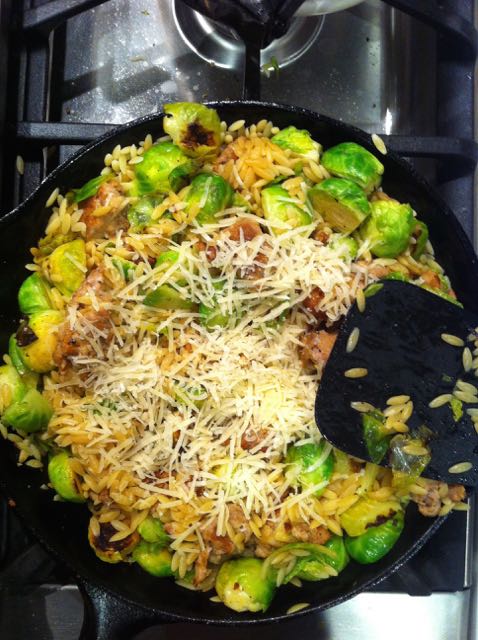Do you have a food friend? Someone you can talk to about what you’ve been cooking lately, what new technique you’ve figured out, or what cookbook you’ve just gotten on loan from the library? One of my favourite people also happens to be a fabulous cook and someone I would describe as a food friend. She doesn’t mind (and I think also enjoys) a somewhat lengthy discussion about grocery stores, new cookbooks, and meals for toddlers. She also re-introduced me to crepes and their versatility in the kitchen. She fills them with scrambled eggs, with fruit and yogurt, or serves them with lemon juice and icing sugar. There are a lot of things you can stuff in a crepe.
It was therefore somewhat fortuitous that this season’s LCBO Food and Drink magazine had a recipe for Honey and Curry Roasted Chicken and Brie Crepes with Honey-Ginger Yogurt Sauce. Clearly it was meant to be.
This recipe has a lot of steps. One of which I added. Brine. Brine your pork chops. Brine your chicken breasts. Brine it all. I started brining (not sure that’s a word) a few years ago after reading about it in TheKitchn. Brining involves allowing a meat to rest in a salt water solution with other aromatics (or not) for about 20 minutes before marinading or cooking. The meat itself will absorb the extra liquid and some of the salt creating a more flavourful and juicy meat for cooking. The recommended ratio is 1tbsp salt:1c water.
If you make nothing else, make the marinade for the chicken. We’ve been eating the leftover chicken on salads all week. It’s really great. Just be sure to brine your chicken first.
Honey and Curry Roasted Chicken and Brie Crepes with Honey-Ginger Yogurt Sauce.
4 boneless, skinless chicken breasts
500g brie, sliced into 1/4” thick slices
2 c chopped kale, cooked
Brine:
Heat 3c water and 4 tbsp salt stirring until dissolved. Add an additional 1c of water. Submerge the meat in the solution and add any additional aromatics (e.g. bay leaf, peppercorns, star anise etc). Allow to bring for 20-30 minutes.
Marinade:
2 tbsp olive oil
2 tbsp honey
2 tbsp curry powder (use the good stuff, I got mine from The Spice Trader)
1 tsp ginger powder
1 tsp garlic powder (I used dried, minced garlic)
1 tsp ground cumin
1 tsp ground coriander
1 shallot, diced
1/2 tsp red pepper flakes
freshly ground black pepper
nutmeg
Dry off the brined chicken. Putting the chicken between two pieces of parchment paper, pound the chicken until roughly an equal thickness. Combine the marinade ingredients into a paste. Smear the paste onto both sides of the chicken. Allow to marinade for up to 2 hours (or the 20 minutes it took my oven to preheat).
Preheat your oven to 350F. Place the chicken breasts in a small roasting pan. Cover with foil and roast for approximately 1 hour or until juices run clear-ish. Slice the chicken into 1/4” slices, cover and set aside until ready to use.
Crepes:
2 c all-purpose flour
freshly ground pepper (omit this if you want to use your leftover batter for breakfast crepes)
2 eggs
3 c whole milk
2 tbsp melted butter or olive oil
1 tbsp minced fresh sage leaves (again omit if you want to have breakfast crepes)
non-stick spray (or butter) for cooking
Combine the ingredients (except the sage and the non-stick spray or butter for cooking), using an immersion blender or really strong arms until smooth. For best performance, let sit 24 hours (in the fridge). I do not have that kind of patience. My crepes turned out just fine.
Heat a 10” skillet over medium heat. When the pan is hot, spray lightly with non-stick spray or a small nub of butter. Pour 1/4 c of batter into the pan, using your other hand, tilt and swirl the pan to coat with batter. Flip the crepe when golden brown underneath. Cook for an additional minutes or so. Transfer to a plate.
Honey-Ginger Yogurt Sauce:
1/2 c plain greek yogurt
1 tbsp fresh ginger, grated
1 1/2 tsp honey
nutmeg
fresh ground pepper
Combine the yogurt sauce ingredients together in a small bowl. Season to taste. Set aside in the fridge until ready to serve.
Assembly:
Lay a crepe on a plate. Place a few slices of chicken, a slice of brie and some kale onto the centre of the crepe. Follow the top of the crepe over the filling, fold in the ends and bring the bottom of the crepe up (like a small package). Set aside, seam side down. Make the desired number of crepes.
In a large skillet over medium heat, add a knob of butter. Lay, a few at a time, the filled crepes seam-side down to seal the opening. Flip once crispy and golden. Transfer to your serving dish or to individual plates. Top with the Honey-Ginger Yogurt Sauce.


